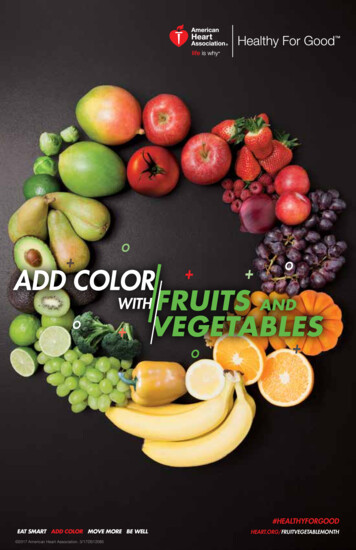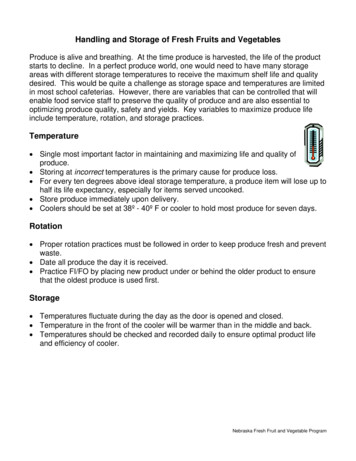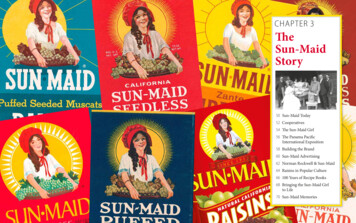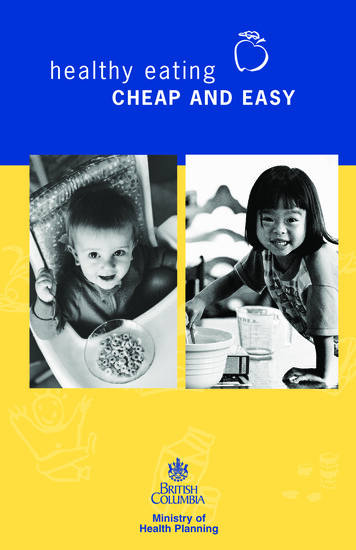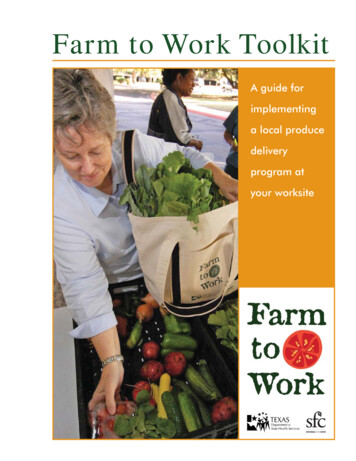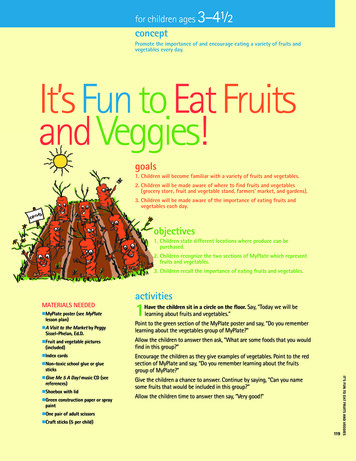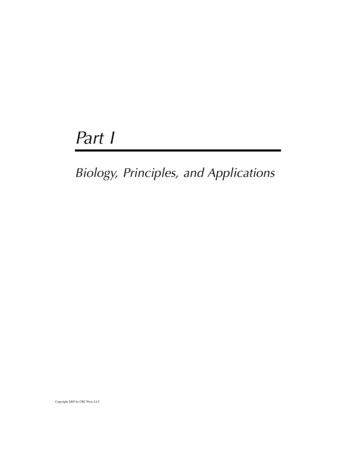
Transcription
1478 SD01.fm Page 1 Wednesday, July 7, 2004 8:06 AMPart IBiology, Principles, and ApplicationsCopyright 2005 by CRC Press LLC
1478 C01.fm Page 3 Wednesday, July 7, 2004 8:06 AMComposition of1 Classification,Fruits, and PostharvestMaintenance of QualityAdel A. Kader and Diane M. BarrettCONTENTS1.11.21.31.41.51.6Classification of Fruits1.1.1Temperate-Zone Fruits1.1.2Subtropical Fruits1.1.3Tropical FruitsContribution of Fruits to Human Nutrition1.2.1Energy (Calories)1.2.2Vitamins1.2.3Minerals1.2.4Dietary Fiber1.2.5AntioxidantsFactors Influencing Composition and Quality of Fruits1.3.1Preharvest Factors1.3.2Maturity at Harvest and Harvesting Method1.3.3Postharvest FactorsFruit Maturity, Ripening, and Quality RelationshipsComposition and Compositional .5.4Organic Acids1.5.5Pigments1.5.6Phenolic iological Factors Involved in Postharvest Deterioration of Fruits1.6.1Respiration1.6.2Ethylene Production1.6.3Transpiration or Water Loss1.6.4Physiological Disorders1.6.5Physical Damage1.6.6Pathological Breakdown .Copyright 2005 by CRC Press LLC
1478 C01.fm Page 4 Wednesday, July 7, 2004 8:06 AM4Processing Fruits: Science and Technology, Second Edition1.7Environmental Factors Influencing Deterioration of Fruits1.7.1Temperature1.7.2Relative Humidity1.7.3Air Movement1.7.4Atmospheric Composition1.7.5Ethylene1.8Harvesting Procedures1.9Postharvest Handling 4Sizing1.9.5Ripening1.9.6Inhibiting Ethylene Action1.9.7Cooling1.9.8Storage1.9.9Food Safety Guidelines1.9.10 Food Security Guidelines1.10 Summary: Keys to Successful Handling of Fresh Fruits1.10.1 Maturity and Quality1.10.2 Temperature and Humidity Management Procedures1.10.3 Physical Damage1.10.4 Sanitation Procedures1.10.5 Expedited HandlingReferencesInternet SitesThe quality of processed fruit products depends on their quality at the start of processing; therefore,it is essential to understand how maturity at harvest, harvesting methods, and postharvest handlingprocedures influence quality and its maintenance in fresh fruits between harvest and processinitiation. Using such information, an appropriate system for harvesting and handling each kind offruit can be selected and used in conjunction with an effective quality control program to ensurethe best quality possible for fresh fruits when processed.Quality attributes of fresh fruits include appearance, texture, flavor, and nutritive value. Appearance factors include size, shape, color, and freedom from defects and decay. Texture factors includefirmness, crispness, and juiciness. Flavor components incorporate sweetness, sourness (acidity),astringency, bitterness, aroma, and off-flavors. Nutritional quality is determined by a fruit’s contentof vitamins (A and C are the most important in fruits), minerals, dietary fiber, carbohydrates,proteins, and antioxidant phytochemicals (carotenoids, flavonoids, and other phenolic compounds).Safety factors that may influence the quality of fresh fruits include residues of pesticides, presenceof heavy metals, mycotoxins produced by certain species of fungi, and microbial contamination.Losses in fresh fruits between harvest and processing may be quantitative (e.g., water loss,physical injuries, physiological breakdown, and decay) or qualitative (e.g., loss of acidity, flavor,color, and nutritive value). Many factors influence fruit quality and the extent of postharvest lossesthat can occur in the orchard, during transportation, and throughout the handling system (sorting,sizing, ripening, cooling, and storage). The total time between harvesting and processing may alsobe an important factor in maintaining the quality and freshness of fruit. Minimizing the delaysthroughout the postharvest handling system greatly reduces quality loss, especially in highlyperishable fruits such as strawberries, raspberries, blackberries, apricots, and cherries.Copyright 2005 by CRC Press LLC
1478 C01.fm Page 5 Wednesday, July 7, 2004 8:06 AMClassification, Composition of Fruits, and Postharvest Maintenance of Quality51.1 CLASSIFICATION OF FRUITSFruit are commonly classified by growing region as follows: temperate-zone, subtropical, andtropical. Growing region and environmental conditions specific to each region significantly affectfruit quality. Examples of fruit grown in each region are listed below.1.1.1 TEMPERATE-ZONE FRUITS1. Pome fruits: apple, Asian pear (nashi), European pear, quince2. Stone fruits: apricot, cherry, nectarine, peach, plum3. Small fruits and berries: grape (European and American types), strawberry, raspberry,blueberry, blackberry, cranberry1.1.2 SUBTROPICAL FRUITS1. Citrus fruits: grapefruit, lemon, lime, orange, pummelo, tangerine, and mandarin2. Noncitrus fruits: avocado, cherimoya, fig, kiwifruit, olive, pomegranate1.1.3 TROPICAL FRUITS1. Major tropical fruits: banana, mango, papaya, pineapple2. Minor tropical fruits: carambola, cashew apple, durian, guava, longan, lychee, mangosteen, passion fruit, rambutan, sapota, tamarind1.2 CONTRIBUTION OF FRUITS TO HUMAN NUTRITIONFruits are not only colorful and flavorful components of our diet, but they also serve as a sourceof energy, vitamins, minerals, and dietary fiber. The U.S. Department of Agriculture DietaryGuidelines encourage consumers to enjoy “five a day,” i.e., eat at least two servings of fruit andthree servings of vegetables each day and to choose fresh, frozen, dried, or canned forms of avariety of colors and kinds of fruits and vegetables. In some countries, consumers are encouragedto eat up to 10 servings of fruits and vegetables per day. For more information access one or moreof the following Websites: www.nutrition.gov, www.5aday.gov, and www.5aday.org.1.2.1 ENERGY (CALORIES)1. Carbohydrates: banana, breadfruit, jackfruit, plantain, dates, prunes, raisin2. Proteins and amino acids: nuts, dried apricot, fig3. Fats: avocado, olive, nuts1.2.2 VITAMINS1. Fresh fruits and vegetables contribute about 91% of vitamin C, 48% of vitamin A, 27%of vitamin B6, 17% of thiamin, and 15% of niacin to the U.S. diet.2. The following fruits are important contributors (based on their vitamin content and theamount consumed) to the supply of indicated vitamins in the U.S. diet:Vitamin A: apricot, peach, cherry, orange, mango, papaya, persimmon, pineapple, cantaloupe, watermelonVitamin C: strawberry, orange, grapefruit, kiwifruit, pineapple, banana, apple, cantaloupeNiacin: peach, banana, orange, apricotRiboflavin: banana, peach, orange, apple, avocadoThiamin: orange, banana, grapefruit, appleCopyright 2005 by CRC Press LLC
1478 C01.fm Page 6 Wednesday, July 7, 2004 8:06 AM6Processing Fruits: Science and Technology, Second Edition1.2.3 MINERALS1. Fresh fruits and vegetables contribute about 26% of the magnesium and 19% of the ironto the U.S. diet.2. The following fruits are important contributors to the supply of indicated minerals in theU.S. diet:Potassium: banana, peach, orange, apple, dried fruits such as apricot and prunePhosphorus: banana, orange, peach, fig, raisinCalcium: tangerine, grapefruit, orangeIron: strawberry, banana, apple, orange1.2.4 DIETARY FIBER1. All fruits and nuts contribute to dietary fiber. Dietary fiber consists of cellulose, hemicellulose, lignin, and pectic substances, which are derived primarily from fruit cell wallsand skin.2. The dietary fiber content of fruits ranges from 0.5 to 1.5% (fresh weight basis).3. Dietary fiber plays an important role in relieving constipation by increasing water-holdingcapacity of feces. Its consumption is also linked to decreased incidence of cardiovasculardisease, diverticulosis, and colon cancer.1.2.5 ANTIOXIDANTS1. Fruits, nuts, and vegetables in the daily diet have been strongly associated with reducedrisk for some forms of cancer, heart disease, stroke, and other chronic diseases. This isattributed, in part, to their content of antioxidant phytochemicals.2. Red, blue, and purple fruits (such as apple, blackberry, blueberry, blood orange, cranberry,grape, nectarine, peach, plum, prune, pomegranate, raspberry, and strawberry) are goodsources of flavonoids and other phenolic compounds that are positively correlated withantioxidant capacity of the fruit.3. Orange-flesh fruits (such as apricot, cantaloupe, mango, nectarine, orange, papaya, peach,persimmon, and pineapple) and some red-flesh fruits (such as tomato, watermelon, andpink grapefruit) are good sources of carotenoids. Availability of lycopene to humans isincreased during tomato processing.1.3 FACTORS INFLUENCING COMPOSITION AND QUALITYOF FRUITS1.3.1 PREHARVEST FACTORS1. Genetic: selection of cultivars, rootstocks. Cultivar and rootstock selection are importantbecause there are often differences in raw fruit composition, postharvest-life potential,and response to processing. In many cases, fruit cultivars grown for fresh market saleare not optimal cultivars for processing.2. Climatic: temperature, light, wind. Climatic factors may have a strong influence onnutritional quality of fruits. Light intensity significantly affects vitamin concentration, andtemperature influences transpiration rate, which will affect mineral uptake and metabolism.3. Cultural practices: soil type, soil nutrient and water supply, pruning, thinning, pestcontrol. Fertilizer addition may significantly affect the mineral content of fruit, whileother cultural practices such as pruning and thinning may influence nutritional composition by changing fruit crop load and size.Copyright 2005 by CRC Press LLC
1478 C01.fm Page 7 Wednesday, July 7, 2004 8:06 AMClassification, Composition of Fruits, and Postharvest Maintenance of Quality1.3.2 MATURITYATHARVESTAND7HARVESTING METHODMaturity at harvest is one of the primary factors affecting fruit composition, quality, and storagelife. Although most fruits reach peak eating quality when harvested fully ripe, they are usuallypicked mature, but not ripe to decrease mechanical damage during postharvest handling. Harvestingmay also mechanically damage fruit; therefore, choice of harvest method should allow for maintenance of quality.1.3.3 POSTHARVEST FACTORS1. Environmental: temperature, relative humidity, atmospheric composition. Temperaturemanagement is the most important tool for extension of shelf life and maintenance ofthe quality of fresh fruit. Relative humidity influences water loss, decay development,incidence of some physiological disorders, and uniformity of fruit ripening. Optimalrelative humidity for storage of fruits is 85 to 90%. Finally, atmospheric composition(O2, CO2, and C2H4, in particular) can greatly affect respiration rate and storage life.2. Handling methods: Postharvest handling systems involve the channels through whichharvested fruit reaches the processing facility or consumer. Handling methods should bechosen such that they maintain fruit quality and avoid delays.3. Time period between harvesting and consumption: Delays between harvesting and cooling or processing may result in direct losses (due to water loss and decay) and indirectlosses (decrease in flavor and nutritional quality).1.4 FRUIT MATURITY, RIPENING, AND QUALITY RELATIONSHIPSMaturity at harvest is the most important factor that determines storage life and final fruit quality.Immature fruits are more subject to shriveling and mechanical damage, and are of inferior qualitywhen ripened. Overripe fruits are likely to become soft and mealy with insipid flavor soon afterharvest. Fruits picked either too early or too late in the season are more susceptible to physiologicaldisorders and have a shorter storage life than those picked at mid-season.With very few exceptions (e.g., pears, avocados, and bananas), all fruits reach their best eatingquality when allowed to ripen on the tree or plant. In general, fruits become sweeter, more colorful,and softer as they mature. However, some fruits are usually picked mature but unripe so that theycan withstand the postharvest handling system when shipped long distances. Most currently usedmaturity indices are based on a compromise between those indices that would ensure the best eatingquality to the consumer and those that provide the needed flexibility in transportation and marketing.Fruits can be divided into two groups: (1) nonclimacteric fruits that are not capable of continuingtheir ripening process once removed from the plant, and (2) climacteric fruits that can be harvestedmature and ripened off the plant. Following are examples of each group:Group 1: Berries (e.g., blackberry, cranberry, raspberry, strawberry), grape, cherry, citrus (grapefruit, lemon, lime, orange, mandarin, tangerine), pineapple, pomegranate, lychee, tamarillo, loquat.Group 2: Apples, pear, quince, persimmon, apricot, nectarine, peach, plum, kiwifruit, avocado,banana, plantain, mango, papaya, cherimoya, sapodilla, sapota, guava, passion fruit.Fruits of the first group (nonclimacteric) produce very small quantities of ethylene and do notrespond to ethylene treatment except in terms of degreening (degradation of chlorophyll) in citrusfruits and pineapples. Fruits in Group 2 (climacteric) produce much larger quantities of ethylenein association with their ripening and exposure to ethylene treatment will result in faster and moreuniform ripening.Copyright 2005 by CRC Press LLC
1478 C01.fm Page 8 Wednesday, July 7, 2004 8:06 AM8Processing Fruits: Science and Technology, Second EditionMaturity indices used vary among fruits and often among cultivars within a specific fruit, butgenerally include one or several (combination indices) of the following: fruit size and shape, overallcolor, ground color of the skin, flesh color, flesh firmness, soluble solids content, starch content,acidity, and internal ethylene concentration. Listed below are some examples of maturity indicesthat can be used for selected fruits:IndexElapsed days from full bloom to harvestSizeShape (fullness of fruit shoulders and suture)Dry WeightColor, externalColor, internalFirmnessCompositional factorsStarch contentSoluble solids contentAcid contentSugar/acid ratioTannin contentFruitsApple, pearMost fruitsStone fruitsAvocado, kiwifruitAll fruitsStone fruits, mangoPome and stone fruits, berriesApple, pearPome and stone fruits, grapes, kiwifruitPomegranateCitrus fruits, grapePersimmon1.5 COMPOSITION AND COMPOSITIONAL CHANGESThe flesh of young developing fruits contains very little sugar, and the large amounts of starch,acid, and tannins make them inedible. As the fruits approach maturity, flesh cells enlarge considerably, and sugar content increases while starch, acid, and tannin contents decrease. In addition,certain volatile compounds develop, giving the fruit its characteristic aroma. Chlorophyll degradation (loss of green color) and synthesis of carotenoids (yellow and orange colors) and anthocyanins(red and blue colors) takes place both in the skin and the flesh with fruit ripening. All fruits softenas they ripen due to changes in cell wall composition and structure. In this section, we present anoverview of fruit constituents in relation to quality and changes after harvest.1.5.1 CARBOHYDRATESCarbohydrates are the most abundant and widely distributed food component derived from plants.Fresh fruits vary greatly in their carbohydrate content, with the general range between 10 to25%. The structural framework, texture, taste, and food value of a fresh fruit is related to itscarbohydrate content.Sucrose, glucose, and fructose are the primary sugars found in fruits (Table 1.1), and theirrelative importance varies among commodities. Sugars are found primarily in the cytoplasm andrange from about 0.9% in limes to 16% in fresh figs. Sucrose content ranges from a trace in cherries,grapes, and pomegranate to more than 8% in ripe bananas and pineapple. Such variation influencestaste since fructose is sweeter than sucrose, and sucrose is sweeter than glucose.Starch occurs as small granules within the cells of immature fruits. Starch is converted to sugaras the fruit matures and ripens. Other polysaccharides present in fruits include cellulose, hemicellulose, pectin, and lignin, which are found mainly (up to 50%) in cell walls and vary greatly amongcommodities. These large molecules are broken down into simpler and more soluble compoundsas a result of fruit softening. The transformation of insoluble pectins into soluble pectins iscontrolled, for the most part, by the enzymes pectinesterase and polygalacturonase. Reducedactivities of these two enzymes have been associated with reduced juiciness and poor texture inpeaches that were ripened after storage at 1 C for more than 3 weeks.Copyright 2005 by CRC Press LLC
1478 C01.fm Page 9 Wednesday, July 7, 2004 8:06 AMClassification, Composition of Fruits, and Postharvest Maintenance of Quality9TABLE 1.1Sugar Composition of Selected FruitsSugar (g/100 ml of .511.810.17 09.590.850.671.684.286.941.80 8310.530.590.498.124.868.242.18 0.940.741.040.020.011.561.303.430.19Sorbitol0.20 0.042.95 0.33ND0.27 0.040.09 0.024.08 0.796.29 1.97NDNDNote: ND not detected (less than 0.05 g/100 ml).Source: Van Gorsel, H., C. Li, E.L. Kerbel, M. Smits, and A.A. Kader. 1992.Compositional characterization of prune juice. J. Agric. Food Chem., 40: 784–789.1.5.2 PROTEINSFruits contain less than 1% protein (vs. 9 to 20% protein in nuts such as almond, pistachio, andwalnut). Changes in the level and activity of proteins resulting from permeability changes in cellmembranes may be involved in chilling injury. Enzymes, which catalyze metabolic processes infruits, are proteins that are important in the reactions involved in fruit ripening and senescence. Someof the enzymes important to fruit quality include the PectinesteraseLipoxygenaseAscorbic acid oxidaseChlorophyllaseActionCatalyzes oxidation of phenolics, resulting in formation of brown polymersCatalyzes hydrolysis of glycosidic bonds between adjacent polygalacturonic acidresidues in pectin; results in tissue softeningCatalyzes deesterification of galacturonans in pectin; may result in tissue firmingCatalyzes oxidation of lipids; results in off-odor and off-flavor productionCatalyzes oxidation of ascorbic acid; results in loss of nutritional qualityCatalyzes removal of phytol ring from chlorophyll; results in loss of green color1.5.3 LIPIDSLipids constitute only 0.1 to 0.2% of most fresh fruits, except for avocados, olives, and nuts.However, lipids are very important because they make up the surface wax that contributes to fruitappearance and the cuticle that protects the fruit against water loss and pathogens. Lipids are alsoimportant constituents of cell membranes. The degree of fatty acid saturation establishes membraneflexibility, with greater saturation resulting in less flexibility. Desaturation of fatty acids can occurupon chilling in chilling-sensitive fruits; in which case membranes undergo a phase change (liquidcrystalline to solid gel) at chilling temperatures resulting in disruption of normal metabolism.1.5.4 ORGANIC ACIDSOrganic acids are important intermediate products of metabolism. The Krebs (TCA) cycle is themain channel for the oxidation of organic acids in living cells and it provides the energy requiredCopyright 2005 by CRC Press LLC
1478 C01.fm Page 10 Wednesday, July 7, 2004 8:06 AM10Processing Fruits: Science and Technology, Second EditionTABLE 1.2Organic Acids of Selected FruitsOrganic Acid (mg/100 ml of NectarinePeachPearPlumStrawberryNDNDtr730 92140 39109 16NDND207 35trtrtr114 6trtrtrtr56 4Malic518727285501383358371294199 322058426772162426QuinicTartaricNDNDND774 57136 28121 11220 2214 68NDNDND162 24trNDtrNDNDNDNote: ND not detected, tr trace ( 10 mg/100 ml).Source: Van Gorsel, H., C. Li, E.L. Kerbel, M. Smits, and A.A. Kader. 1992.Compositional characterization of prune juice. J. Agric. Food Chem., 40:784–789.for maintenance of cell integrity. Organic acids are metabolized into many constituents, includingamino acids, which are the building blocks of proteins.Most fresh fruits are acidic with a pH range of 3 to 5. Some fruits, such as lemons and limes,contain as much as 2 to 3% of their total fresh weight as acid. Total titratable acidity, specificorganic acids present and their relative quantities, and other factors influence the buffering systemand affect pH. Acid content usually decreases during ripening due to the utilization of organic acidsduring respiration or their conversion to sugars. Malic and citric acids are the most abundant infruits (Table 1.2), except grapes (tartaric acid is the most important in most cultivars) and kiwifruits(quinic acid is the most abundant).1.5.5 PIGMENTSPigments, which are the chemicals responsible for skin and flesh colors, undergo many changesduring the maturation and ripening of fruits. These include the following:1. Loss of chlorophyll (green color), which is influenced by pH changes, oxidative conditions, and chlorophyllase activity2. Synthesis and revelation of carotenoids (yellow and orange colors)3. Development of anthocyanins (red, blue, and purple colors), which are fruit specific(Table 1.3)Beta-carotene is a precursor to vitamin A and thus is important in terms of nutritional quality.Carotenoids are very stable and remain intact in fruit tissues even when extensive senescence hasoccurred. Anthocyanins occur as glycosides in the cell sap. They are water soluble, unstable, andare readily hydrolyzed by enzymes to free anthocyanins, which may be oxidized by phenoloxidasesto give brown oxidation products.1.5.6 PHENOLIC COMPOUNDSTotal phenolic content is higher in immature than in mature fruits and typically ranges between0.1 and 2 g/100 g fresh weight. Fruit phenolics include chlorogenic acid, catechin, epicatechin,Copyright 2005 by CRC Press LLC
1478 C01.fm Page 11 Wednesday, July 7, 2004 8:06 AMClassification, Composition of Fruits, and Postharvest Maintenance of Quality11TABLE 1.3Anthocyanins of Selected peNectarinePeachPlumStrawberryCyanidin 3-arabinosideCyanidin 7-arabinoside or cyanidin 3-glucosideCyanidin 3-galactosideCyanidin 3-glucosideCyanidin 3-rutinosidePeonidin 3-rutinosideCyanidin 3-glucosideDelphinidin 3-glucosideMalvidin 3-glucosidePeonidin 3-glucosideCyanidin 3-glucosideCyanidin 3-glucosideCyanidin 3-glucosideCyanidin 3-glucosidePelargonidin 3-glucosidePelargonidin 3-glycosidePeak Area222726018913204712158621574783221804270130278 61569401093633110375925143518299Source: Van Gorsel, H., C. Li, E.L. Kerbel, M. Smits, and A.A. Kader. 1992.Compositional characterization of prune juice. J. Agric. Food Chem., 40:784–789.leucoanthocyanidins, flavonols, cinnamic acid derivatives, and simple phenols. Chlorogenic acid(ester of caffeic acid) occurs widely in fruits (Figure 1.1) and is the main substrate involved inenzymatic browning of cut or otherwise damaged fruit tissues when exposed to air.Enzymatic browning occurs due to the oxidation of phenolic compounds and is mediated, inthe presence of O2, by the enzyme polyphenoloxidase (PPO). The initial product of oxidation isusually O-quinone, which is highly unstable and undergoes polymerization to yield brown pigmentsof higher molecular weight. Polyphenoloxidase catalyzes the following two reactions:Monophenol O2 æppOæÆ 2 0-quinone H 2O2 0-diphenol O2 æppOæÆ 2 0-quinone H 2ONormally phenolic compounds are separated from the PPO enzyme in the intact cells of planttissue. Once the tissue is damaged, PPO and the phenolic compounds that it acts on are decompartmentalized and the above-mentioned reactions occur, leading to tissue browning. The extent of browndiscoloration depends upon the total amount of phenolic compounds in the tissue and the level of PPOactivity. Differences among cultivars of a given species in terms of browning potential in response tomechanical injury are related to the variation in the total phenolic content and PPO activity of thecultivar. Differences in phenylalanine ammonia lyase (PAL) enzyme activity influence phenolic content.Astringency is directly related to phenolic content, and it usually decreases with fruit ripeningbecause of conversion of astringent phenolic compounds from the soluble to the insoluble nonastringent form. Loss of astringency occurs via (1) binding or polymerization of phenolics, (2) changein molecular size of phenolics, and (3) change in the hydroxylation pattern of phenolic compounds.There is a strong positive relationship between phenolic content and antioxidant capacity offruits and their products.Copyright 2005 by CRC Press LLC
1478 C01.fm Page 12 Wednesday, July 7, 2004 8:06 AM12Processing Fruits: Science and Technology, Second Editionchlorogenic acid( )-epicatechin2caffeic echerryplumprunepearferulic kiwi2018nectarine2220apple2422cherryPhenol concentration (mg per 100 ml juice)( )-catechin24phloridzin420FIGURE 1.1 Phenolic compounds of selected fruits.1.5.7 VOLATILESVolatiles are responsible for the characteristic aroma of fruits. They are present in extremely smallquantities ( 100 mg/g fresh wt.). The total amount of carbon involved in the synthesis of volatilesis 1% of that expelled as CO2. The major volatile formed in climacteric fruits is ethylene (50 to75% of the total carbon content of all volatiles). Ethylene does not have a strong aroma and doesnot contribute to typical fruit aromas.Volatile compounds are largely esters, alcohols, acids, aldehydes and ketones (low-molecularweight compounds). Very large numbers of volatile compounds have been identified in fruits andmore are identified as advances in separation and detection techniques and gas chromatographicmethods are made. However, only a few key volatiles are important for the particular aroma of agiven fruit. Their relative importance depends upon threshold concentration (which can be as lowas 1 ppb), potency, and interaction with other compounds.1.5.8 VITAMINSThe water-soluble vitamins include vitamins C, thiamin, riboflavin, niacin, vitamin B6, folacin,vitamin B12, biotin, and pantothenic acid. Fat-soluble vitamins include vitamins A, D, E, and K.Fat soluble vitamins are less susceptible to postharvest losses.Ascorbic acid is most sensitive to destruction when the commodity is subjected to adversehandling and storage conditions. Losses are enhanced by extended storage, higher temperatures,low relative humidity (which may cause wilting), physical damage, and chilling injury. Postharvestlosses in vitamins A and B are usually much smaller than losses in vitamin C. They are, however,susceptible to degradation at high temperatures in the presence of oxygen.1.5.9 MINERALSImportant fruit minerals include base-forming elements (Ca, Mg, Na, and K) and acid-formingelements (P, Cl, S). Minerals present in microquantities include Fe, Cu, Co, Mn, Zn, I, and Mo.High nitrogen content is often associated with reduced soluble solids content, lower acidity, andincreased susceptibility to physiological disorders in fruits.Copyright 2005 by CRC Press LLC
1478 C01.fm Page 13 Wednesday, July 7, 2004 8:06 AMClassification, Composition of Fruits, and Postharvest Maintenance of Quality13TABLE 1.4Classification of Fruits According to Their Respiration Rates and Degree ofPerishability under Optimum ConditionsRelative Respiration Rateand PerishabilityFruitsVery lowLowModerateHighVery highNuts, dates, dried fruitsApple, pear, kiwifruit, pomegranate, Chinese date (jujube)Citrus fruits, banana, cherry, nectarine, peach, plum, avocado (unripe), persimmonApricot, fig (fresh), avocado (ripe), cherimoya, papayaStrawberry, blackberry, raspberryPotassium is the most abundant mineral found in fruits. It most often occurs in combinationwith organic acids. High potassium content is often associated with increased acidity and improvedcolor of fruits.Calcium is the second most important mineral constituent and is associated primarily with thecell wall. High calcium contents reduce CO2 and C2H4 production rates, delay ripening, reduce theincidence of physiological disorders, and extend the storage life of apples and other fruits. Calciumdeficiency has been associated with several physiological disorders such as bitter pit of apples.Magnesium is a component of the chlorophyll molecule, which is responsible for the intensityof green color in fresh produce. Phosphorus is a constituent of cytoplasmic and nuclear proteinsand plays a major role in carbohydrate metabolism and energy transfer. High phosphorus contentmay result in decreased acidity in some fruits.1.6 BIOLOGICAL FACTORS INVOLVED IN POSTHARVESTDETERIORATION OF FRUITS1.6.1 RESPIRATIONRespiration is the process by which stored organic materials (carbohydrates, proteins, and fats) arebroken down into simple end products with a release of energy. Oxygen (O2) is used in this process,and carbon dioxide (CO2) is produced. The loss of stored food reserves in the commodity duringrespiration hastens senescence as the reserves that provide energy to maintain the commodity’sliving status are exhausted. For the consumer, food value (energy value) is gone, flavor quality isreduced, and sweetness, especially, is lost. Salable dry weight is also lost (especially important forcommodities destined for dehydration). The energy released as heat, which is known as vital heat,affects postharvest technology considerations such as estimations of refrigeration and ventilationrequirements. The rate of deterior
, 17% of thiamin, and 15% of niacin to the U.S. diet. 2. The following fruits are important contributors (based on their vitamin content and the amount consumed) to the supply of indicated vitamins in the U.S. diet: Vitamin A: apricot, peach, cherry, orange, man




